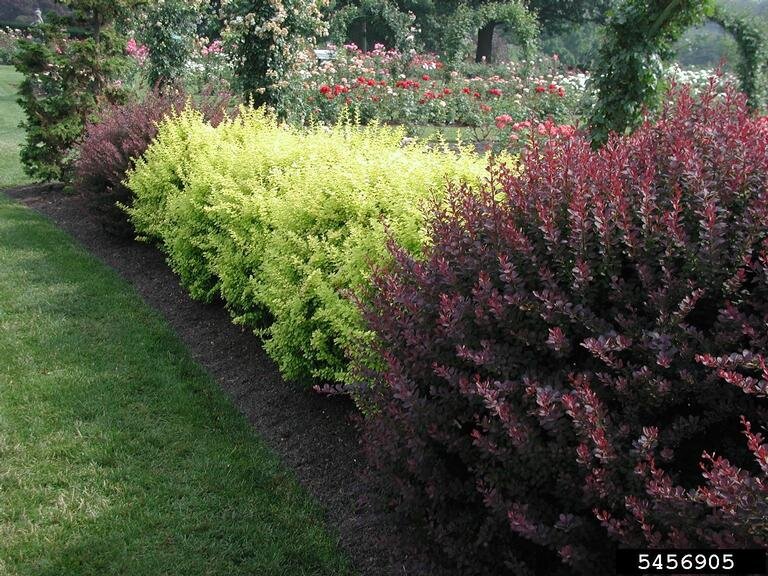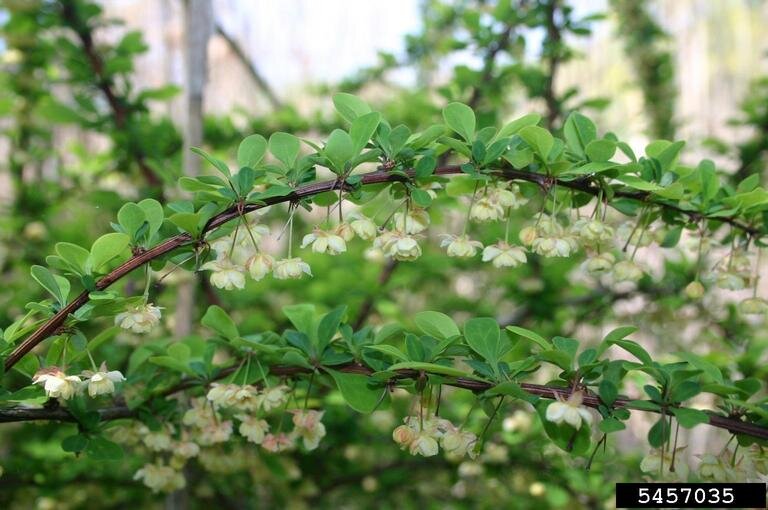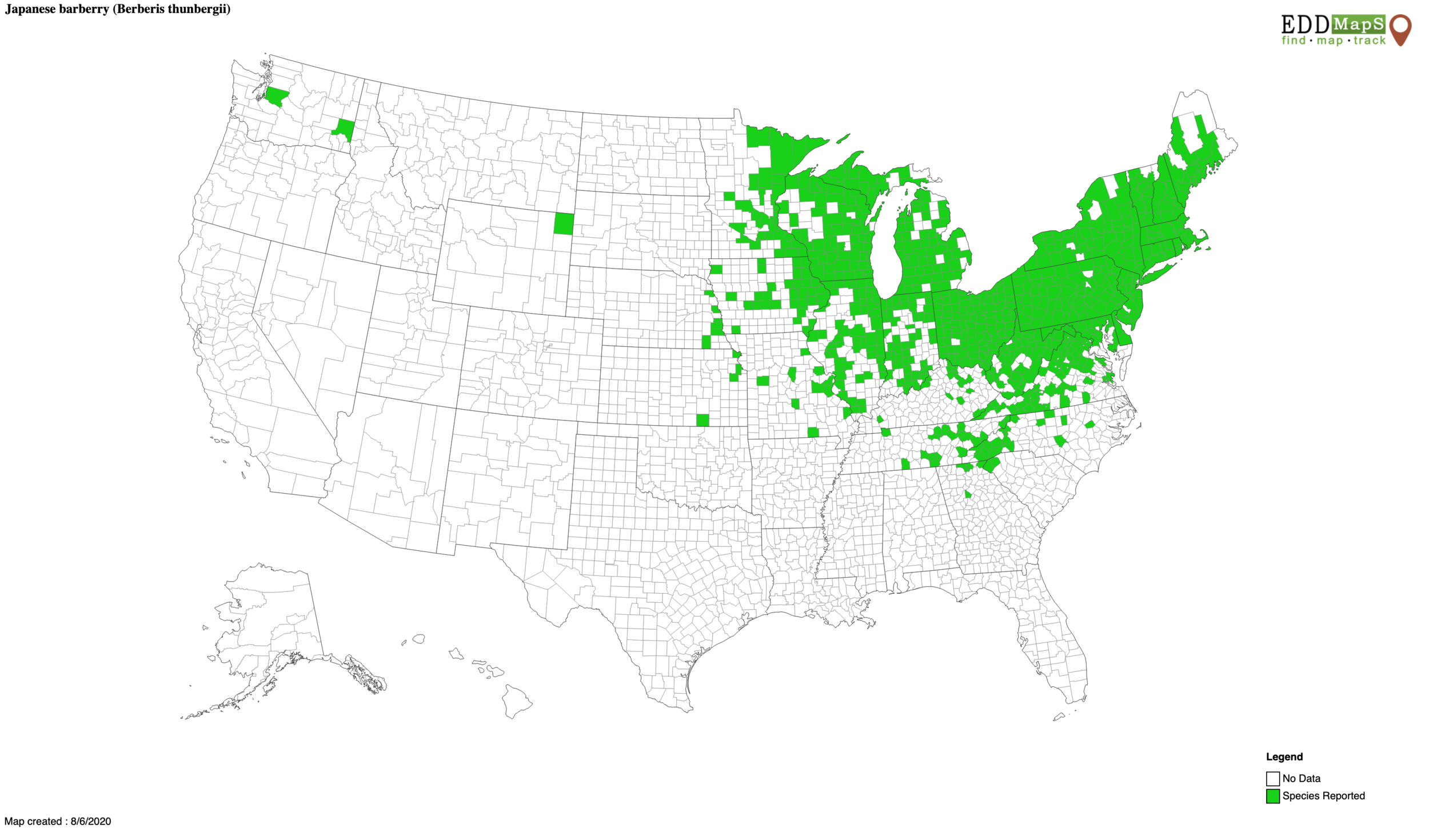August Invasive Plant of the Month
SICIM Email
Japanese barberry (Berberis thunbergii)
Japanese barberry is a low, compact, spiny shrub, typically 2-3’ tall, but can grow to be taller. It was introduced from Japan for hedge plantings and ornamental value. Japanese barberry prefers shaded or semi-shaded habitats on mesic, fertile soils, but can adapt to a wide variety of conditions. Birds disperse the seeds widely. Established individuals spread vegetatively through horizontal lower branches that take root when they touch the soil. Japanese barberry is widespread throughout Indiana and has been widely used for landscaping and hedges.
IDENTIFICATION & BIOLOGY: Japanese barbery is a deciduous shrub with dense foliage, multiple stems originating from the crown as well as rhizomatous shoots emerging further from the base of the shrub. Stems are grooved, hairless, purplish-red turning reddish-brown with age, and inner bark is bright yellow. The leaves are small (up to 1 inch long) and paddle-shaped, often growing in clusters in the axils, above single spines. The leaves are hairless, with green upper surfaces and dull under surfaces. Certain cultivars can have bluish-green to dark reddish-purple leaves, which shift to prominently red to purple in the fall. It produces yellow to cream flowers in the spring with 6 petals, borne individually or in few-flowered clusters. Fruits are bright red, oblong berries that persist into winter.
LOOK-A-LIKES: The native American barberry (Berberis canadensis) was locally frequent historically in Indiana. Unlike Japanese barberry, American barberry has toothed leaves and up to 3 trifurcate spines in its leaf axils. American barberry was the target of an eradication program by the US Department of Agriculture due to it being an alternate host for stem rust (Puccinia graminea), a serious pest of cereal crops. Only one surviving population is known in Indiana, along the Tippecanoe River.
HABITAT & DISTRIBUTION: This invasive species adapts to a wide range of conditions and spreads aggressively in mesic to dry areas that are open to semi-open, also occurring in moist shady woodlands. Japanese barberry is currently reported throughout much of the northeastern US, stretching down to northern Tennessee and North Carolina.
ECOLOGICAL THREAT: Due to its increasingly wide distribution and ability to form dense thickets in mature forest communities, Japanese barberry outcompetes native plants, interrupts food webs, and reduces wildlife biodiversity. Invasions can alter soil microbial composition and increase nitrate concentrations. White-tailed deer do not eat the toxic foliage, therefore assisting indirectly with its ability to dominate natural areas. Its ability to thrive in a wide range of conditions also allows for increase in spread.
CONTROL:
Prevention - The first priority to limit the spread is to stop the use of Japanese barberry in ornamental landscape plantings and remove it from any existing intentional plantings. This species is regulated under the Indiana Terrestrial Plant Rule, which prohibits the sale, trade, etc. of this species in Indiana.
Manual - For small areas of Japanese barberry or individual shrubs, you can pull or dig out plant parts as they have a shallow root system. However, any stem or root material left behind may give rise to continued growth. For larger areas, manual removal is discouraged since this soil disturbance can encourage spread.
Chemical – Treatment with systemic herbicides such as glyphosate (non-selective) or triclopyr (broadleaf specific) has been shown to be effective, both as a foliar spray and cut-stump method. Cut-stump treatment is effective on larger specimens, in areas of high infestation, or where other desirable species occur.
IMPORTANT: The pesticide label is the law! When using any chemical control, always read the entire pesticide label carefully, follow all mixing and application instructions and use all personal protective gear and clothing specified. Contact county level Purdue Extension or Office of Indiana State Chemist (OISC) for additional pesticide use requirements, restrictions or recommendations.
Fire & Cultural – Fire likely only top-kills Japanese barberry, and it has been seen to re-sprout after prescribed burning. It is more likely to invade areas affected by human disturbance, but not exclusively. Studies have shown that Japanese barberry creates a humid microclimate favorable for blacklegged ticks that carry Lyme disease.
Maintenance - Initial control efforts should be monitored regularly over the course of multiple years such that continued chemical and/or cultural control of persistent or new infestations may be required.
JAPANESE BARBERRY HANDOUT: https://www.invasive.org/weedcd/pdfs/wow/japanese-barberry.pdf
JAPANESE BARBERRY REFERENCES & OTHER RESOURCES:
https://www.fs.fed.us/database/feis/plants/shrub/berthu/all.html
https://www.illinoiswildflowers.info/trees/plants/jp_barberry.htm
https://www.invasive.org/gist/products/handbook/methods-handbook.pdf
https://www.minnesotawildflowers.info/shrub/japanese-barberry http://www.misin.msu.edu/facts/detail.php?id=178
LOOK-A-LIKE REFERENCES:
#japanesebarberry #barberry #berberisthunbergii #indianainvasiveplants #indianainvasviesinitiative





